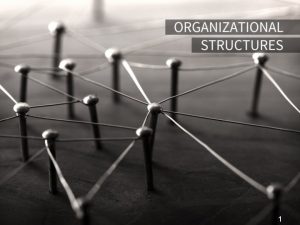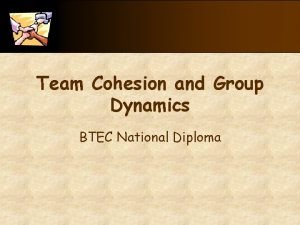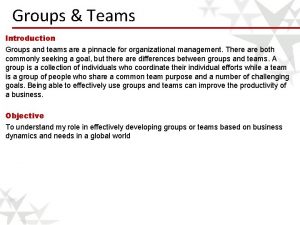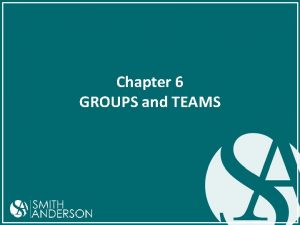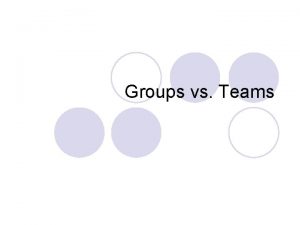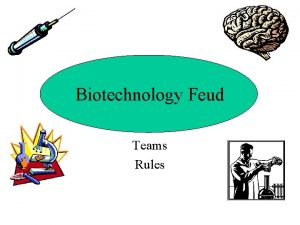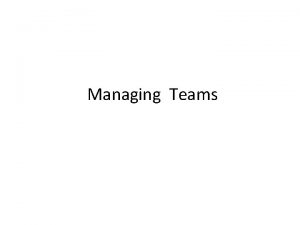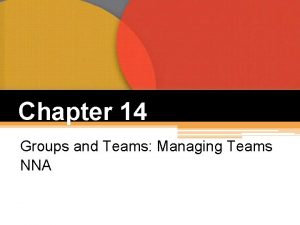Lecture 6 GROUPS AND TEAMS FORMATION AND STRUCTURE



















- Slides: 19

Lecture 6 GROUPS AND TEAMS: FORMATION AND STRUCTURE For use with MARTIN, ORGANIZATIONAL BEHAVIOUR AND MANAGEMENT 3 e ISBN 1 -86152 -948 -1 Copyright © 2005 Cengage Learning 1

Definition of a group • Various definitions but all imply: More than one person involved Interaction must take place Purpose or intention Awareness For use with MARTIN, ORGANIZATIONAL BEHAVIOUR AND MANAGEMENT 3 e ISBN 1 -86152 -948 -1 Copyright © 2005 Cengage Learning 2

Groups and teams • Katenbach & Smith suggest that difference between group and team is that of performance and describe the following scale: – Working group – Pseudo-teams – Potential teams – Real teams – High performance teams For use with MARTIN, ORGANIZATIONAL BEHAVIOUR AND MANAGEMENT 3 e ISBN 1 -86152 -948 -1 Copyright © 2005 Cengage Learning 3

Groups, teams and organizations Hierarchical differentiation Specialism groupings Activity groupings Boundary spanning Professional For use with MARTIN, ORGANIZATIONAL BEHAVIOUR AND MANAGEMENT 3 e ISBN 1 -86152 -948 -1 Copyright © 2005 Cengage Learning 4

For use with MARTIN, ORGANIZATIONAL BEHAVIOUR AND MANAGEMENT 3 e ISBN 1 -86152 -948 -1 Copyright © 2005 Cengage Learning 5

The significance of groups Arises as a result of two factors: • Necessity – the need to organize activity • Dynamic – nature of human behaviour For use with MARTIN, ORGANIZATIONAL BEHAVIOUR AND MANAGEMENT 3 e ISBN 1 -86152 -948 -1 Copyright © 2005 Cengage Learning 6

Formal and informal groups Argyle’s formal groups • Technology • Teams • Decisions • Tasks • Management Informal groups exist within all organizations: • Friendship or common interest • Hofstede’s marketplace bureaucracy (1984) • Reliance more on personal relations that formal reporting to get things done • Negative role of informal relations and networks in excluding women from management positions - Cooper and Davidson (1982) For use with MARTIN, ORGANIZATIONAL BEHAVIOUR AND MANAGEMENT 3 e ISBN 1 -86152 -948 -1 Copyright © 2005 Cengage Learning 7

Why groups form • The need to have more than one person undertake work • The need to incorporate the expertise of a number of people to achieve a result • The need to match complexity in the environment through provision of internal operating methods and arrangements • Opportunity to minimise worst aspects of work by sharing • Provide for social needs of individuals • A basis for socialization into the norms of behaviour within the organization • Protection from outside threat • Groups also emerge as a result of the nature of work to be undertaken within an organization For use with MARTIN, ORGANIZATIONAL BEHAVIOUR AND MANAGEMENT 3 e ISBN 1 -86152 -948 -1 Copyright © 2005 Cengage Learning 8

Informal group creation Informal groups come into existence for a number of reasons: • Nature and form of formal organization • Need to function in a social environment and form relationships • Voluntary form of informal groups offsets the involuntary nature of formal groups • Approach of managers running the organization • Need to run the organization For use with MARTIN, ORGANIZATIONAL BEHAVIOUR AND MANAGEMENT 3 e ISBN 1 -86152 -948 -1 Copyright © 2005 Cengage Learning 9

Research approaches Triplett (1897) - social facilitation • Better performance of racing cyclists if accompanied by a pacesetter The British experience (Wyatt et al. 1928) • Social conditions within which work carried out are significant • Boredom less likely in groups The Hawthorne Studies • The illumination experiments • The relay assembly test room study • The interview programme • The bank wiring observation room study For use with MARTIN, ORGANIZATIONAL BEHAVIOUR AND MANAGEMENT 3 e ISBN 1 -86152 -948 -1 Copyright © 2005 Cengage Learning 10

Key findings of the Hawthorne Studies • Informal groups inevitably form within formally designated groupings • Informal groups will not always match the groupings designated by management • Workers are not simply motivated by pay and other tangible benefits • Informal groups will attempt to form a bottom-up management in order to influence their working environment • Rewards from a group may be more significant than anything offered by management • Informal groups may seek to frustrate management’s intentions and objectives • The groups to which an individual belongs will have influence on their attitudes to work • First-line managers are subjected to increasing pressures from above and below • Management has no influence on formation informal groups • Informal groups can engage in competitive activities that are against the interests of the organization For use with MARTIN, ORGANIZATIONAL BEHAVIOUR AND MANAGEMENT 3 e ISBN 1 -86152 -948 -1 Copyright © 2005 Cengage Learning 11

Group formation Homans (1950) - three elements of a group: • Culture • Physical • Technological For use with MARTIN, ORGANIZATIONAL BEHAVIOUR AND MANAGEMENT 3 e ISBN 1 -86152 -948 -1 Copyright © 2005 Cengage Learning 12

For use with MARTIN, ORGANIZATIONAL BEHAVIOUR AND MANAGEMENT 3 e ISBN 1 -86152 -948 -1 Copyright © 2005 Cengage Learning 13

Tuckman and Jensen’s model of group development Stage 1 - Forming Stage 2 - Storming Stage 3 - Norming Stage 4 - Performing Stage 5 - Adjourning For use with MARTIN, ORGANIZATIONAL BEHAVIOUR AND MANAGEMENT 3 e ISBN 1 -86152 -948 -1 Copyright © 2005 Cengage Learning 14

Feldman (1984) Groups will adopt a satisficing approach to regulating individual behaviour unless: • Group survival is at risk • Lack of clarity in the expected behaviour of group members is creating problems in group activity or performance • By taking action the group can avoid bringing into the open things that would be embarrassing or difficult to resolve • The central values held by the group are being threatened For use with MARTIN, ORGANIZATIONAL BEHAVIOUR AND MANAGEMENT 3 e ISBN 1 -86152 -948 -1 Copyright © 2005 Cengage Learning 15

Dimensions on which the structure of a group is dependant Huczynski and Buchanan (2001) • Status • Power • Liking • Role • Leadership For use with MARTIN, ORGANIZATIONAL BEHAVIOUR AND MANAGEMENT 3 e ISBN 1 -86152 -948 -1 Copyright © 2005 Cengage Learning 16

The components of the role theory - Handy (1993) • Role set • Role definition • Role ambiguity • Role incompatibility • Role conflict • Role overload/underload • Role stress For use with MARTIN, ORGANIZATIONAL BEHAVIOUR AND MANAGEMENT 3 e ISBN 1 -86152 -948 -1 Copyright © 2005 Cengage Learning 17

Job design, technology and groups • More than one person does the same job • Multi-disciplinary work teams • Autonomous work groups • Introduction of technology to a work situation fundamentally changes the design of the jobs people undertake For use with MARTIN, ORGANIZATIONAL BEHAVIOUR AND MANAGEMENT 3 e ISBN 1 -86152 -948 -1 Copyright © 2005 Cengage Learning 18

Groups are significant to managers and organizations as well as the individuals that belong to them The process of management involves the management of groups Managers must be part of some of the groups that they manage Managers are also part of the management group Moves towards managers empowering employees Group activity is a large part of the individuals time within and organization Informal groups can create a shadow organization For use with MARTIN, ORGANIZATIONAL BEHAVIOUR AND MANAGEMENT 3 e ISBN 1 -86152 -948 -1 Copyright © 2005 Cengage Learning 19
 How many people
How many people Groups and teams difference
Groups and teams difference Groups and teams difference
Groups and teams difference Understanding groups and teams
Understanding groups and teams Understanding groups and teams
Understanding groups and teams Understanding groups and teams
Understanding groups and teams How are ethnic groups and religious groups related
How are ethnic groups and religious groups related 01:640:244 lecture notes - lecture 15: plat, idah, farad
01:640:244 lecture notes - lecture 15: plat, idah, farad Formation initiale vs formation continue
Formation initiale vs formation continue Muscle tissue parts
Muscle tissue parts Group of cells that are similar in structure and function
Group of cells that are similar in structure and function Target market departmentalization example
Target market departmentalization example Chapter 10 motivating employees
Chapter 10 motivating employees Motivating and satisfying employees and teams
Motivating and satisfying employees and teams Chapter 10 motivating and satisfying employees and teams
Chapter 10 motivating and satisfying employees and teams Motivating and satisfying employees and teams
Motivating and satisfying employees and teams Copyright
Copyright Examples of social loafing in sport
Examples of social loafing in sport Peopleware productive projects and teams
Peopleware productive projects and teams Communicating in teams and organizations
Communicating in teams and organizations











